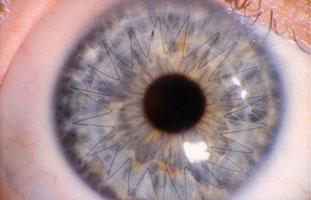

The cornea is a completely transparent tissue and acts as the first refracting (focusing) surface of the eye. Clear vision is dependent on a clear, smooth, and round cornea. When the cornea becomes irregularly shaped, scarred, or cloudy, corneal transplantation may be needed. In a corneal transplant, the surgeon uses donated tissue to replace one, or all, layers of the cornea.
A qualified and trained anesthesiologist will be in the operating room to provide you with anesthesia to keep you comfortable. Oftentimes this is intravenous (IV) sedation, sometimes termed “twilight” sedation. Numbing medication applied to the surface of the eye will eliminate sensation and the surgeon may decide to place a retrobulbar block to numb up the entire eye throughout the duration of the procedure. Occasionally, for either ocular health reasons or patient health concerns, a general anesthetic may be required where the patient is completely asleep throughout the procedure.
The decision to replace a single layer versus the entire cornea is dependent on where the problem exists in the cornea. When the problem exists deep in the cornea (such as scarring) or involves all layers of the cornea (such as infections or perforations), a full-thickness transplant may be necessary. This is called a Penetrating Keratoplasty (PKP). In this surgery, the surgeon prepares a graft from donor tissue that replaces all layers of your cornea.
There are several layers to the cornea. The outermost layer is called the epithelium – it is a specialized cell layer that acts as a barrier between the deeper layers of the cornea and the outside world. It protects the cornea, much like the skin cells in the rest of your body. It is rare to need a transplant to replace this layer. However, when these cells are dysfunctional they may need to be replaced. We do not replace the epithelial cells themselves. Rather, we perform a procedure called a limbal stem cell transplant. This transplant replaces the bed of stem cells that produce the epithelium. Unlike other forms of transplantation, the source of this graft is often times your own stem cells.
The layer below the epithelium is called the stroma, this layer provides the majority of the structural support of the cornea. The collagen fibers in this layer are oriented in a very unique way that makes it clear. When these structures become disorganized, the result is opacity. The cornea becomes opaque and can change shape, resulting in diminished vision. When the stroma of the cornea is affected, this layer may need to be replaced. Your surgeon can replace the whole cornea (Penetrating Keratoplasty) or she can perform a special procedure called a DALK (Deep Anterior Lamellar Keratoplasty), which allows the inner-most layer (endothelium) to remain. The decision to perform a full-thickness transplant versus a DALK is specific to your eye, and your surgeon will discuss which option is best for you.
The innermost layer is called the endothelium. This layer is critical to corneal clarity because it works to pull water from the stroma of the cornea. Fuchs Dystrophy is the most common disease affecting this layer and can result in corneal swelling and blurry vision. When this layer loses its ability to remove fluid from the cornea, it becomes swollen and opaque. Endothelial cells from a donor can resume this critical pumping function and return clarity to the cornea. Your surgeon can replace this layer either with a DSAEK (Descemet’s Stripping Automated Endothelial Keratoplasty) or DMEK (Descemet’s Membrane Endothelial Keratoplasty).
Colorado Eye Consultants is dedicated to the preservation of sight and providing patients with the quality of life they deserve. Our patients receive personalized care by knowledgeable and experienced board certified ophthalmologists to ensure the clarity needed to see the most important things in their world. Your vision is our utmost priority and we offer same day appointments to ensure you get the care you deserve!
Request an Appointment